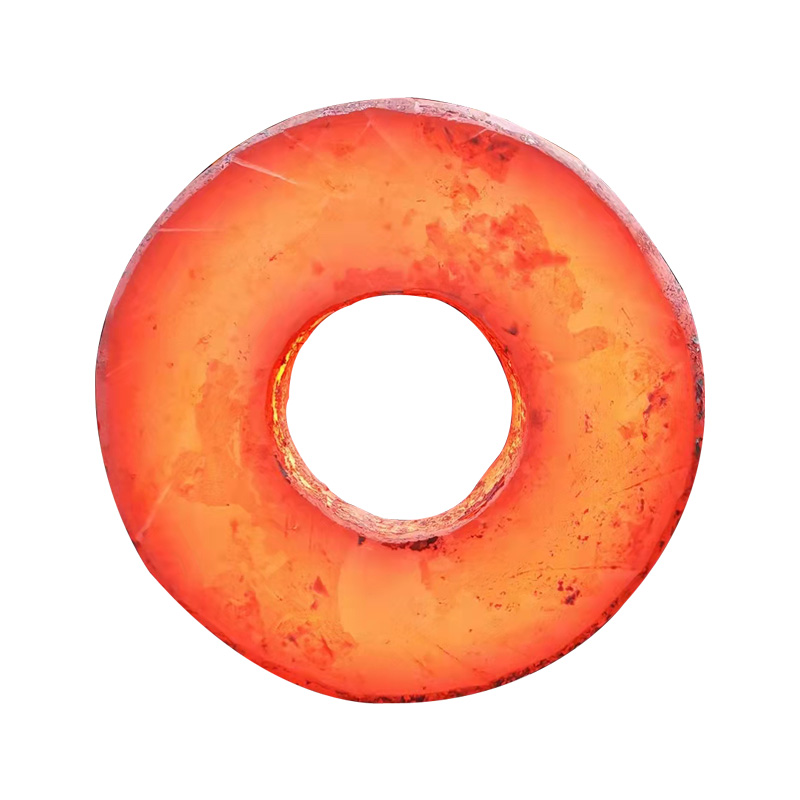What are the main defects in common forgings?
2022-09-07
In the process of free forging production, the common main defects of forgings are as follows:
1. Transverse cracks, such as deep surface transverse cracks, are mainly caused by poor quality of raw materials and metallurgical defects of ingot, according to wind power forgings manufacturers. Often appear in the early forging, once found with oxygen blown away, to avoid subsequent forging crack expansion. If it is a shallow surface transverse crack, it may be caused by ingot subcutaneous bubbles exposed on the surface and welding failure, or it may be caused by excessive relative feed halo used in drawing. The causes of internal cracks are: high temperature stress caused by too fast heating speed at low temperature of cold ingot, or too small relative feeding amount of low plastic billet length.
2. In addition to the poor metallurgical quality of ingot, the surface longitudinal crack appearing when the longitudinal crack is upset or drawn by fire may also be caused by excessive amount of pressing during chamfering.
As for the internal longitudinal crack, when the crack appears at the end of the riser, the wind power forgings manufacturer said that it was caused by insufficient cutting head of the ingot shrinkage pipe or secondary shrinkage hole during forging. If the crack in the forging center area, heating will not burn through, the center temperature is too low, or the upper and lower flat anvil used when the round billet deformation is too large. When drawing high alloy steel with low plasticity, when the feed is too large or the same position is repeatedly drawn. It can cause cross cracks.
3. Surface crack When the content of copper, tin, arsenic and sulfur in steel is high and the initial forging temperature is too high, shallow tortoiseshel-like cracks will appear on the surface of the forging.
4. Internal microcracks are caused by failure to forge loose central tissue, which often coexists with non-metallic inclusions, also known as inclusion cracks.
5. Local coarse grain forging surface or internal local area of coarse grain. The reason is that the heating temperature is high, the deformation is not uniform, and the local deformation degree (forging ratio) is too small.
6. Fold the surface. This is because the anvil at the rounded corner is too small, the feed is less than the amount of pressure.
7. Center deviation, such as uneven billet temperature during heating or uneven pressing amount during forging operation, will lead to ingot center and forging center do not coincide, affecting the quality of forging.
8. Mechanical properties do not meet the requirements. The unqualified strength index of forgings is related to steelmaking and heat treatment. Wind power forgings manufacturers say that the unqualified transverse mechanical properties (plasticity and toughness) are caused by excessive smelting impurities or insufficient upsetting ratio.

1. Transverse cracks, such as deep surface transverse cracks, are mainly caused by poor quality of raw materials and metallurgical defects of ingot, according to wind power forgings manufacturers. Often appear in the early forging, once found with oxygen blown away, to avoid subsequent forging crack expansion. If it is a shallow surface transverse crack, it may be caused by ingot subcutaneous bubbles exposed on the surface and welding failure, or it may be caused by excessive relative feed halo used in drawing. The causes of internal cracks are: high temperature stress caused by too fast heating speed at low temperature of cold ingot, or too small relative feeding amount of low plastic billet length.
2. In addition to the poor metallurgical quality of ingot, the surface longitudinal crack appearing when the longitudinal crack is upset or drawn by fire may also be caused by excessive amount of pressing during chamfering.
As for the internal longitudinal crack, when the crack appears at the end of the riser, the wind power forgings manufacturer said that it was caused by insufficient cutting head of the ingot shrinkage pipe or secondary shrinkage hole during forging. If the crack in the forging center area, heating will not burn through, the center temperature is too low, or the upper and lower flat anvil used when the round billet deformation is too large. When drawing high alloy steel with low plasticity, when the feed is too large or the same position is repeatedly drawn. It can cause cross cracks.
3. Surface crack When the content of copper, tin, arsenic and sulfur in steel is high and the initial forging temperature is too high, shallow tortoiseshel-like cracks will appear on the surface of the forging.
4. Internal microcracks are caused by failure to forge loose central tissue, which often coexists with non-metallic inclusions, also known as inclusion cracks.
5. Local coarse grain forging surface or internal local area of coarse grain. The reason is that the heating temperature is high, the deformation is not uniform, and the local deformation degree (forging ratio) is too small.
6. Fold the surface. This is because the anvil at the rounded corner is too small, the feed is less than the amount of pressure.
7. Center deviation, such as uneven billet temperature during heating or uneven pressing amount during forging operation, will lead to ingot center and forging center do not coincide, affecting the quality of forging.
8. Mechanical properties do not meet the requirements. The unqualified strength index of forgings is related to steelmaking and heat treatment. Wind power forgings manufacturers say that the unqualified transverse mechanical properties (plasticity and toughness) are caused by excessive smelting impurities or insufficient upsetting ratio.

Previous:How are forgings cooled?
X
We use cookies to offer you a better browsing experience, analyze site traffic and personalize content. By using this site, you agree to our use of cookies.
Privacy Policy



